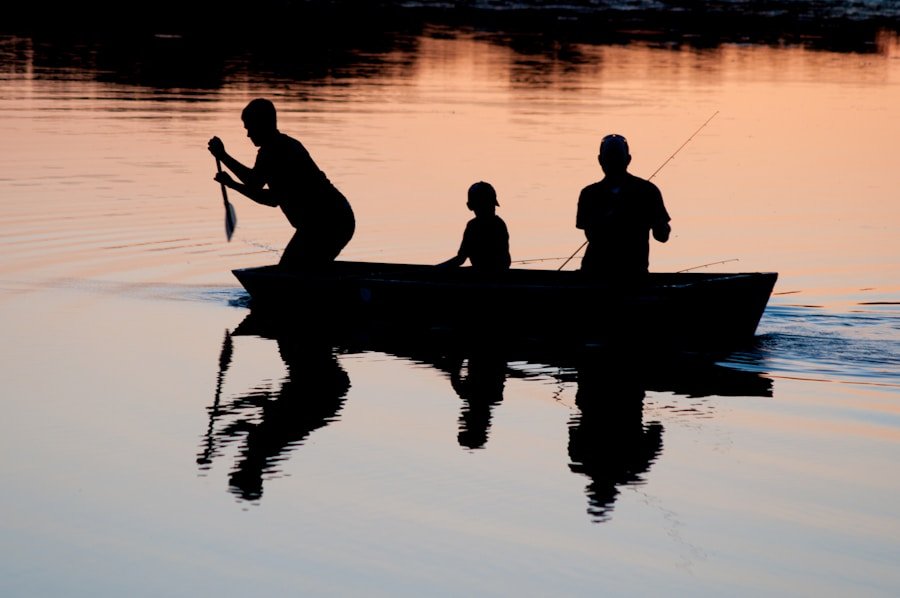Canoeing and kayaking are two of the most popular water-based activities among families who enjoy camping. These pursuits offer a distinctive way to explore the natural environment and create enduring memories with family members. One of the primary advantages of canoeing and kayaking is the opportunity to foster family bonding while appreciating the outdoors.
These activities necessitate teamwork and communication, which can help fortify family relationships and promote a sense of unity. Furthermore, canoeing and kayaking provide an excellent physical workout for both children and adults. Paddling through water requires strength and endurance, making it a fun and challenging physical activity for the entire family.
Another benefit of canoeing and kayaking is the opportunity to establish a unique connection with nature. These activities enable families to explore remote and inaccessible areas that are not reachable by foot or vehicle. This provides a chance to observe wildlife up close and experience the beauty of nature in a way that is not possible in other settings.
Canoeing and kayaking also offer a sense of adventure and excitement, as families navigate through rivers, lakes, and streams, encountering various challenges along the way. Overall, canoeing and kayaking provide an opportunity for families to disconnect from technology and connect with each other and the natural world.
Key Takeaways
- Canoeing and kayaking on family camping trips provide a thrilling way to navigate nature and explore scenic routes.
- The benefits of canoeing and kayaking for family camping trips include physical exercise, bonding opportunities, and a chance to explore nature’s beauty.
- Choosing the right canoe or kayak for your family adventure involves considering factors such as size, stability, and ease of use for kids.
- Safety tips for canoeing and kayaking with kids include wearing life jackets, staying close to shore, and teaching kids basic paddling techniques.
- Fun and educational activities for kids while canoeing and kayaking can include wildlife spotting, learning about ecosystems, and practicing navigation skills.
Choosing the Right Canoe or Kayak for Your Family Adventure
When planning a family camping trip that includes canoeing or kayaking, it’s important to choose the right watercraft for your adventure. Canoes are typically larger and more stable, making them a great option for families with younger children or those who want to bring along camping gear or other supplies. On the other hand, kayaks are smaller and more maneuverable, making them a good choice for families who want to explore narrow waterways or tackle more challenging rapids.
When choosing a canoe or kayak, it’s important to consider the skill level of your family members, as well as the type of water you will be navigating. In addition to choosing the right type of watercraft, it’s also important to consider the material and design of the canoe or kayak. For families who plan to do a lot of portaging or carrying their watercraft over land, a lightweight and durable material such as fiberglass or Kevlar may be the best option.
Families who plan to navigate through rocky or shallow waters may want to choose a watercraft with a flat bottom to prevent damage. Ultimately, the right canoe or kayak for your family adventure will depend on your specific needs and preferences, so it’s important to do your research and consider all options before making a decision.
Safety Tips for Canoeing and Kayaking with Kids
Safety should always be a top priority when participating in water activities with kids, especially when canoeing or kayaking. Before heading out on the water, it’s important to ensure that everyone in your family has the proper safety gear, including life jackets that fit properly and are approved by the U.S. Coast Guard. It’s also important to teach kids about water safety and how to properly use their paddles to navigate through the water. Additionally, families should be aware of weather conditions and water levels before heading out on their adventure, as these factors can greatly impact safety on the water. Another important safety tip for canoeing and kayaking with kids is to stay together as a group at all times. It’s easy for kids to get excited and paddle ahead, but it’s important to emphasize the importance of staying close together to prevent accidents or getting lost. Families should also be aware of potential hazards in the water, such as rocks, logs, or strong currents, and take precautions to avoid these obstacles. By following these safety tips and being prepared for any situation, families can enjoy a safe and fun canoeing or kayaking adventure with their kids.
Exploring Nature’s Beauty: Scenic Routes for Canoeing and Kayaking
| Activity | Number of Participants | Duration |
|---|---|---|
| Canoeing | 25 | 2 hours |
| Kayaking | 20 | 1.5 hours |
| Camping | 30 | 2 nights |
One of the most exciting aspects of canoeing and kayaking is the opportunity to explore some of nature’s most beautiful landscapes. There are countless scenic routes around the world that offer breathtaking views and unique wildlife encounters for families to enjoy while paddling through the water. In the United States, places like the Boundary Waters Canoe Area Wilderness in Minnesota, the Everglades in Florida, and the Colorado River in Arizona offer stunning natural beauty and diverse ecosystems for families to explore.
These routes provide an opportunity to see wildlife such as bald eagles, alligators, and elk in their natural habitats. In addition to these well-known destinations, there are also countless hidden gems around the world that offer stunning scenery for families to enjoy while canoeing or kayaking. Whether it’s paddling through crystal-clear waters in the Caribbean, navigating through fjords in Norway, or exploring mangrove forests in Costa Rica, there are endless opportunities for families to connect with nature and create lasting memories together.
No matter where you choose to go, canoeing and kayaking provide a unique way to experience the beauty of nature in a way that is not possible through any other means.
Fun and Educational Activities for Kids while Canoeing and Kayaking
Canoeing and kayaking provide an opportunity for kids to learn about nature in a hands-on way while having fun at the same time. There are countless educational activities that families can enjoy while paddling through the water, such as bird watching, identifying different types of plants and trees, or learning about local wildlife habitats. Many national parks and nature reserves offer guided tours or educational programs that provide kids with an opportunity to learn about the environment while participating in water activities.
In addition to educational activities, there are also plenty of fun games that families can play while canoeing or kayaking. For example, families can have a scavenger hunt where kids search for different types of wildlife or natural features along their route. Another fun activity is to have a race or relay where kids compete against each other in their canoes or kayaks.
These activities not only provide entertainment for kids but also help them develop important skills such as teamwork, problem-solving, and navigation. Overall, canoeing and kayaking provide an opportunity for kids to learn about nature in an engaging way while having fun with their family.
Packing Essentials for a Canoeing and Kayaking Family Camping Trip
When planning a family camping trip that includes canoeing or kayaking, it’s important to pack all of the essentials to ensure a safe and enjoyable experience on the water. Some essential items to pack include life jackets for every member of your family, as well as a first aid kit in case of any accidents or injuries. Families should also bring plenty of sunscreen, hats, and sunglasses to protect themselves from the sun while out on the water.
In addition to these items, families should also pack plenty of water and snacks to stay hydrated and energized during their adventure. Another important item to pack for a canoeing or kayaking trip is a waterproof bag or container to keep valuables such as phones, cameras, and wallets dry while on the water. Families should also bring along any necessary camping gear such as tents, sleeping bags, and cooking supplies if they plan to camp along their route.
It’s also important to pack clothing that is appropriate for the weather conditions, including rain gear in case of unexpected showers. By packing all of these essentials, families can ensure that they are prepared for any situation while enjoying their canoeing or kayaking adventure.
Finding the Best Family-Friendly Campsites for Canoeing and Kayaking Adventures
When planning a family camping trip that includes canoeing or kayaking, it’s important to find a campsite that is suitable for these activities. Many campgrounds around the world offer access to lakes, rivers, or other bodies of water that are perfect for canoeing or kayaking adventures. Some campgrounds even offer rental services for canoes or kayaks so that families can easily access the water without having to bring their own equipment.
When choosing a campsite for your family adventure, it’s important to consider factors such as proximity to the water, availability of amenities such as restrooms and showers, and overall safety. In addition to these practical considerations, it’s also important to find a campsite that offers plenty of opportunities for outdoor recreation and exploration. Many campgrounds offer hiking trails, nature walks, or wildlife viewing areas that provide additional opportunities for families to connect with nature while camping.
Some campgrounds even offer guided tours or educational programs that provide insight into the local environment and wildlife. By choosing a family-friendly campsite that offers access to water activities as well as other outdoor recreation opportunities, families can enjoy a well-rounded camping experience that provides fun and excitement for everyone. In conclusion, canoeing and kayaking provide an exciting way for families to connect with nature while creating lasting memories together.
These activities offer numerous benefits for families, including opportunities for physical activity, bonding, and exploration of natural beauty. When planning a family camping trip that includes canoeing or kayaking, it’s important to choose the right watercraft for your adventure, pack all of the essentials for safety and comfort, and find a family-friendly campsite that offers access to water activities as well as other outdoor recreation opportunities. By following these tips and being prepared for any situation, families can enjoy a safe and fun canoeing or kayaking adventure that provides an opportunity to connect with nature in a unique way.
FAQs
What are the benefits of canoeing and kayaking on family camping adventures?
Canoeing and kayaking provide a great way for families to bond and enjoy the outdoors together. These activities also offer physical exercise, opportunities to explore nature, and the chance to learn new skills.
What safety precautions should be taken when canoeing and kayaking with family?
It is important to wear life jackets, be aware of weather conditions, and stay within designated areas for canoeing and kayaking. Additionally, it is crucial to have proper training and knowledge of water safety.
What equipment is needed for canoeing and kayaking on family camping trips?
Essential equipment includes canoes or kayaks, paddles, life jackets, and safety gear such as whistles and first aid kits. It is also important to have waterproof storage for belongings and proper footwear.
What are some popular destinations for canoeing and kayaking on family camping trips?
Popular destinations for canoeing and kayaking on family camping trips include national parks, rivers, lakes, and coastal areas. Some well-known locations for these activities include the Boundary Waters Canoe Area Wilderness, the Everglades, and the Colorado River.
What are some tips for beginners who want to try canoeing and kayaking on family camping trips?
Beginners should start with calm and shallow waters, take a basic paddling course, and practice basic techniques such as paddling and steering. It is also helpful to go with experienced guides or instructors for the first few trips.













